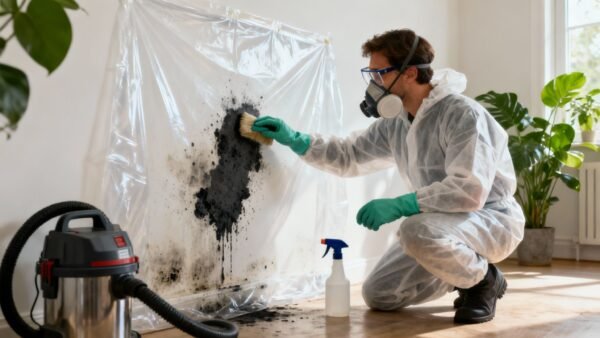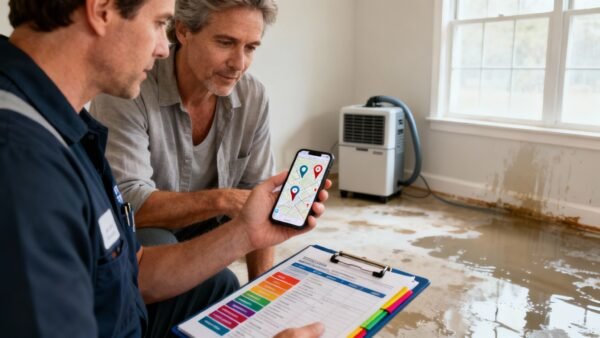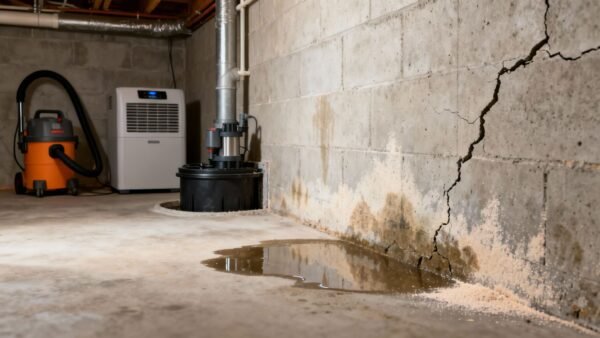Whether from a kitchen mishap, nearby wildfires, or a previous tenant who smoked, the acrid smell of smoke can cling to your home, impacting air quality and comfort. Getting rid of it requires more than just opening a window. Smoke particles are incredibly small and can penetrate everything from drywall to fabric, while the odor embeds itself in surfaces, making it a stubborn problem to solve. Many homeowners in areas like Sherman Oaks or Glendale know how wildfire smoke can suddenly become an indoor issue, making the best way to get smoke out of your house a crucial piece of knowledge.
This guide provides a comprehensive roundup of the 8 most effective methods to clear smoke and restore your home’s air. From simple DIY hacks to professional-grade solutions, we’ll cover the best ways to get smoke out of a house, ensuring you can breathe easy again. For persistent or severe smoke damage, professional assessment is key.
Schedule a Free Inspection Now
1. Mastering Cross-Ventilation for Immediate Relief
When smoke invades your home, whether from a cooking mishap or nearby wildfires, your first and most powerful action is to get the contaminated air out as quickly as possible. Mastering cross-ventilation is the best way to get smoke out of a house for immediate relief. This fundamental technique involves strategically opening windows and doors to create a powerful air current that physically pushes the smoke-filled air out while pulling fresh, clean air in.
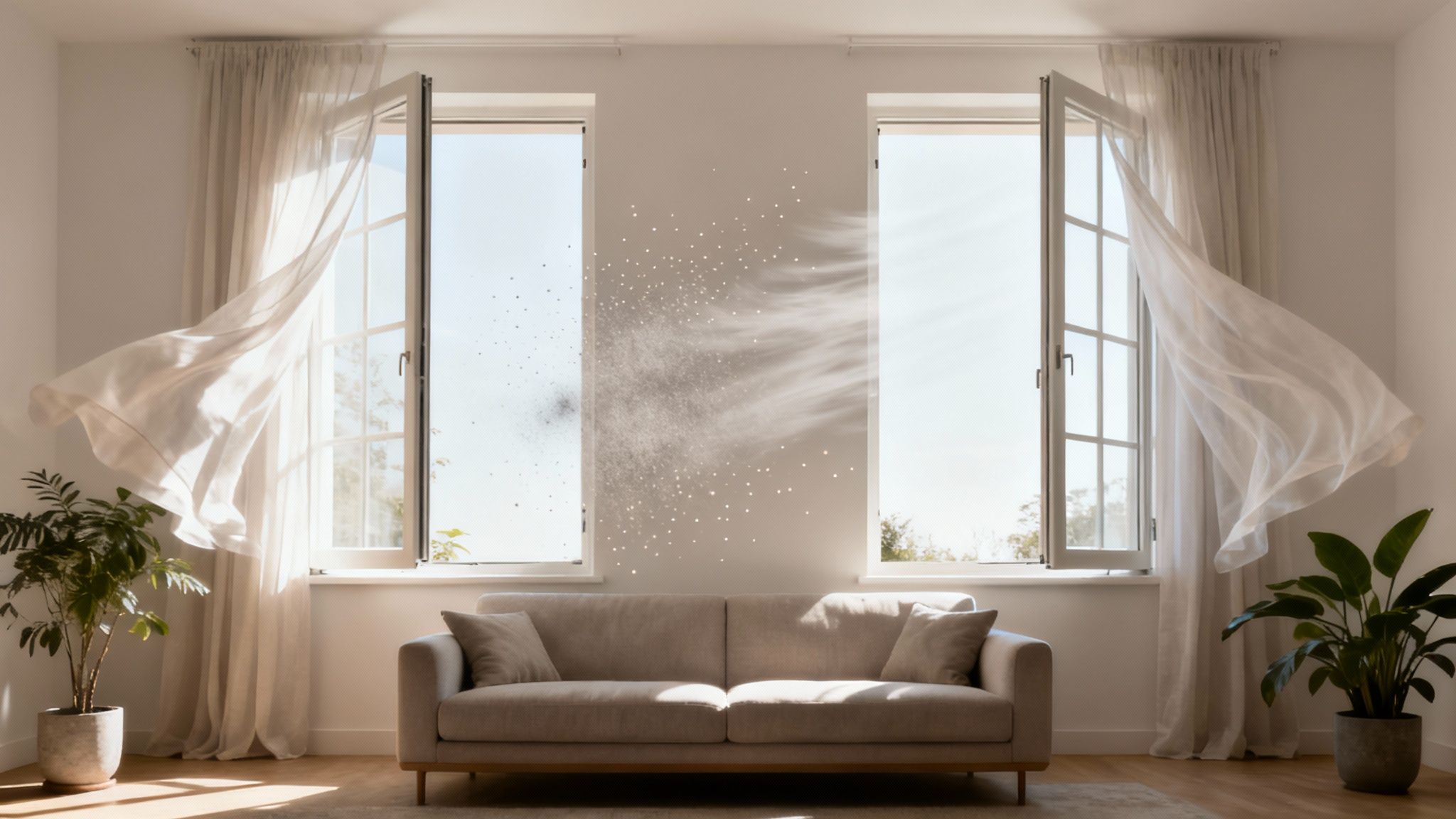
Simply opening one window is not enough; it allows for slow, passive air exchange. The key to effective cross-ventilation is creating a pressure differential. By opening windows on opposite sides of your home, you establish a clear pathway for air to travel, creating a wind tunnel effect that rapidly cycles the air in your living space. This method is your immediate first line of defense, significantly reducing airborne particulate matter and lingering odors before they have a chance to settle into fabrics and onto surfaces.
How to Create an Effective Wind Tunnel
To maximize the effectiveness of this technique, follow these specific steps:
- Identify Your Air Pathway: Locate windows or doors on opposite sides of the affected room or the entire house. For example, in a Sherman Oaks home, you might open a front living room window and a back kitchen door.
- Supercharge the Airflow: Place a box fan in one of the open windows, facing outwards. This actively pushes the smoky air outside, creating negative pressure that pulls fresh air in more forcefully through the other openings.
- Engage Ceiling Fans: Turn on your ceiling fans, ensuring they are spinning counter-clockwise. This helps push air downwards and towards the open windows, breaking up stagnant pockets of smoke that can get trapped in corners or near the ceiling.
Key Insight: Before you begin, always check the local air quality report from sources like the EPA’s AirNow. If outdoor air quality is poor due to wildfires, a common concern in Los Angeles, this method may introduce more pollutants. In such cases, keep windows closed and rely on air purifiers.
2. Deploying HEPA Air Purifiers for Particle Capture
When outdoor air quality is poor or when smoke has already permeated your home, ventilation isn’t always a viable or complete solution. In these scenarios, deploying a High-Efficiency Particulate Air (HEPA) purifier is an excellent way to get smoke out of a house by mechanically scrubbing the air. These devices are engineered to pull indoor air through a dense, fine-fiber filter, capturing microscopic smoke particles that would otherwise settle into your belongings or be inhaled.
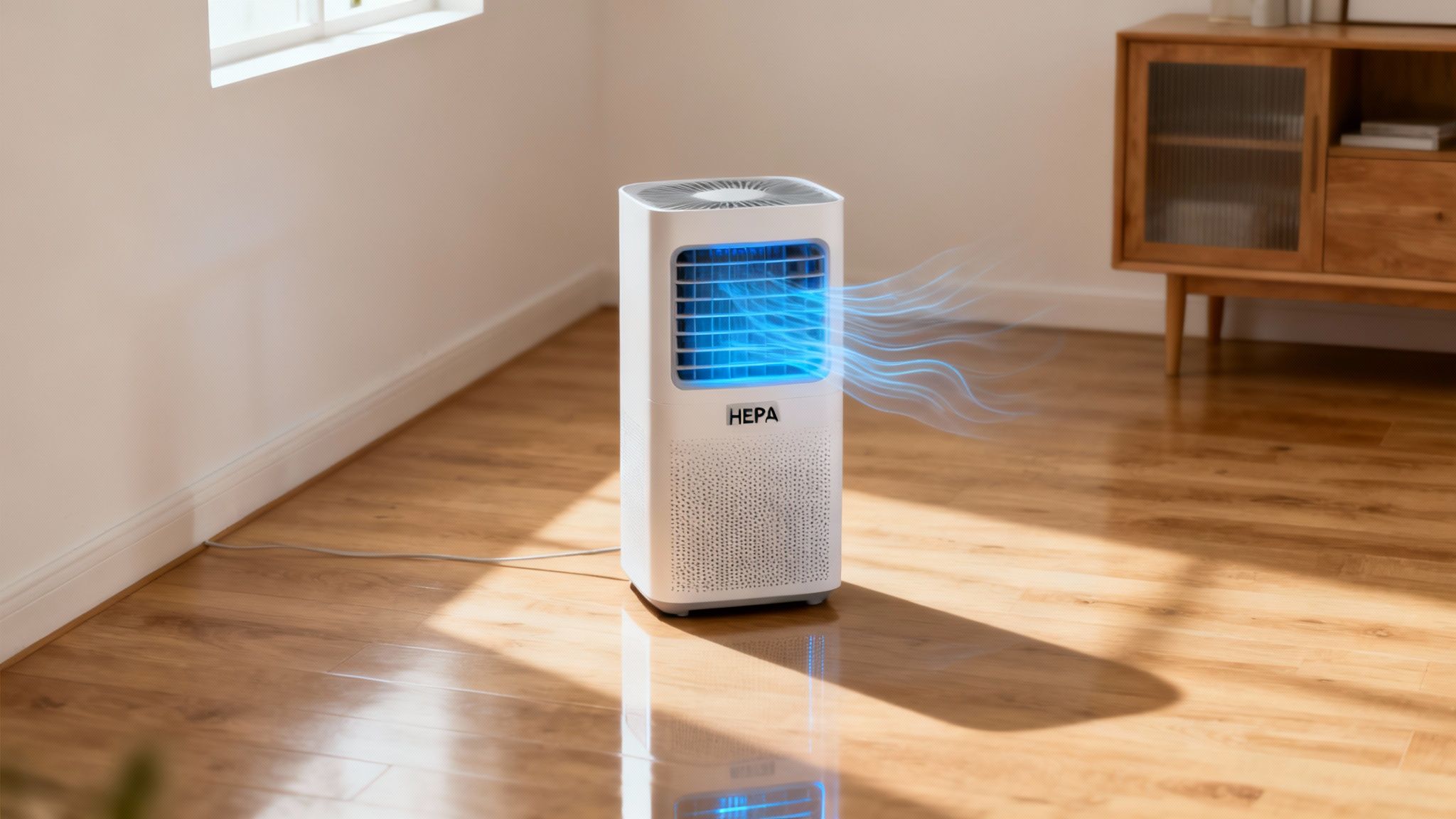
True HEPA filters are a gold standard recommended by the EPA, as they are certified to trap 99.97% of airborne particles as small as 0.3 microns. This includes the fine particulate matter found in smoke from cooking, cigarettes, or wildfires. An air purifier actively circulates and cleans the air within a contained space, making it an indispensable tool for creating a safe breathing zone, especially in bedrooms or common living areas where your family spends the most time. Unlike simple fans that just move smoke around, a HEPA purifier removes it from your environment entirely.
How to Maximize Air Purifier Effectiveness
To ensure your air purifier is performing at its peak, strategic placement and proper maintenance are crucial. Follow these steps for the best results:
- Choose the Right Size: Select a purifier with a Clean Air Delivery Rate (CADR) that matches your room’s square footage.
- Centralize Placement: Place the unit in the center of the room, away from walls and furniture, to ensure unobstructed 360-degree air intake and circulation.
- Create a Closed System: Close all windows and doors in the room where the purifier is running. This prevents new smoke from entering and allows the machine to efficiently clean a contained volume of air.
- Run It Continuously: Operate the purifier 24/7 during and after a smoke event to continually capture lingering particles. Many modern units feature an “auto mode” that adjusts fan speed based on real-time air quality sensors.
- Maintain Your Filters: Check and replace the HEPA and carbon pre-filters according to the manufacturer’s guidelines. A clogged filter severely reduces the purifier’s effectiveness.
Key Insight: While a HEPA filter is excellent for particles, an activated carbon filter is necessary to remove the volatile organic compounds (VOCs) and odors associated with smoke. Look for a combination unit for the most comprehensive smoke removal solution. You can learn more about maintaining high indoor air quality through regular monitoring and filtration.
3. Using Activated Charcoal and Baking Soda for Odor Absorption
After you’ve ventilated the area, the next critical step is to tackle the stubborn, microscopic odor particles that have already settled. While ventilation removes airborne smoke, using activated charcoal and baking soda is the best way to get smoke out of a house when dealing with these lingering smells. These natural substances are highly porous and work through adsorption, a process where odor-causing molecules chemically bind to their vast surface areas, effectively trapping and neutralizing the smell rather than just masking it.
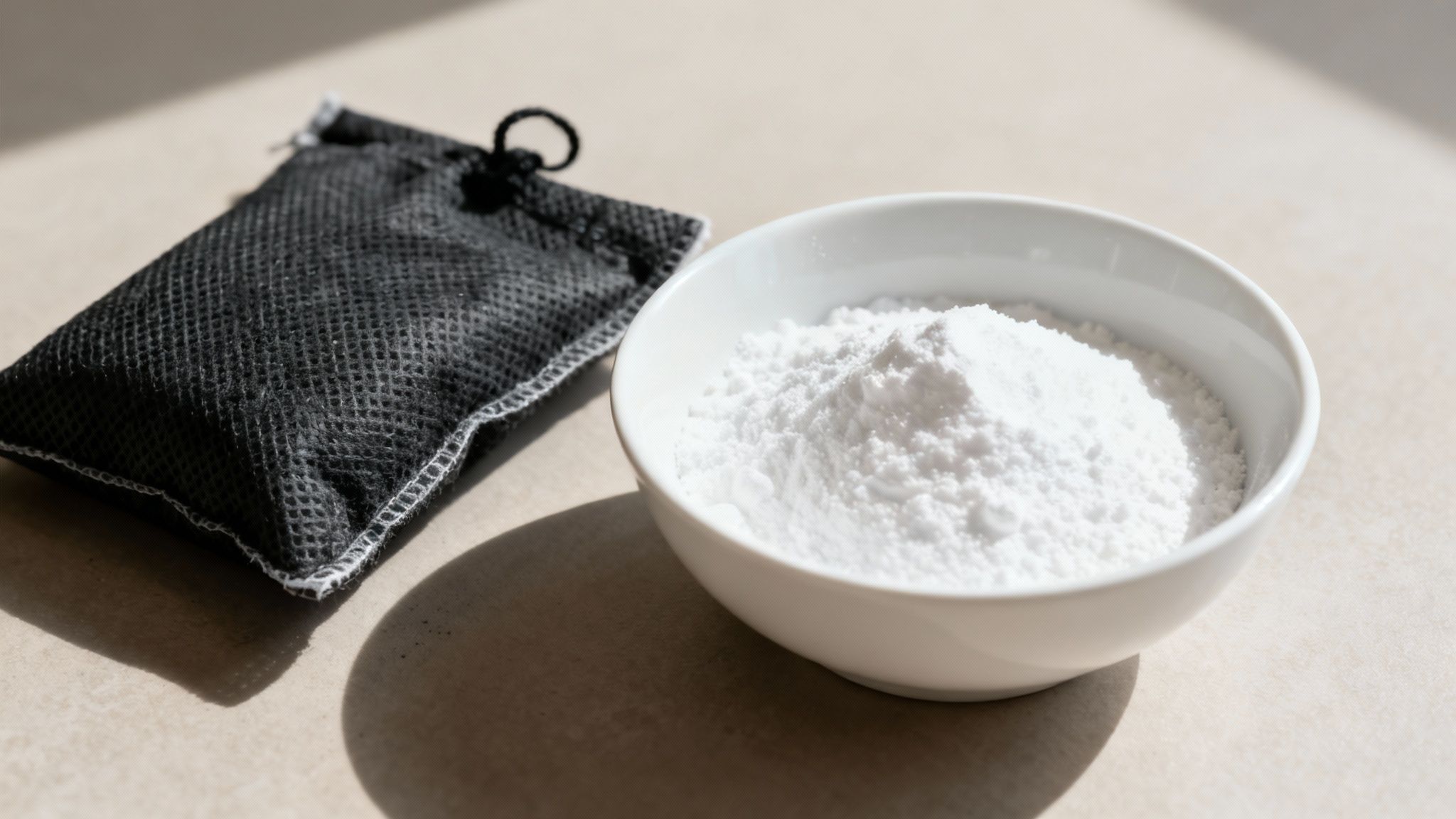
Unlike air fresheners that simply add more chemicals to the air, charcoal and baking soda offer a passive, non-toxic solution to purify your indoor environment. Activated charcoal is particularly effective due to its immense surface area; a single gram can have more surface area than a football field, making it a super-absorbent material for odors. Baking soda (sodium bicarbonate) works similarly by neutralizing acidic smoke molecules, making it a perfect partner in your odor-elimination toolkit. These methods are essential for addressing smoke that has penetrated soft surfaces like carpets, drapes, and furniture.
How to Deploy Natural Odor Absorbers
To effectively use these natural deodorizers, strategic placement and proper application are key:
- Set Up Absorption Stations: Place open bowls of baking soda or activated charcoal briquettes (without lighter fluid) in every affected room. Focus on areas where smoke was heaviest, such as the kitchen after a cooking fire in a North Hollywood apartment.
- Use Breathable Containers: For a cleaner approach, use commercial products like charcoal air purifying bags or create your own DIY pouches by putting activated charcoal into breathable fabric bags. Place these in closets, drawers, and near upholstered furniture.
- Treat Fabrics and Carpets Directly: Liberally sprinkle baking soda over carpets, rugs, and upholstery. Let it sit for at least 24 hours to absorb the odors, then thoroughly vacuum it up using a vacuum with a HEPA filter to capture the fine particles.
Key Insight: These absorption methods are highly effective but work passively over time. For best results, combine them with active ventilation and deep cleaning. For persistent, deeply embedded smoke odors that these methods can’t fully resolve, a professional odor removal service may be necessary to restore your home’s air quality completely.
4. Professional Ozone Treatment: A Powerful Odor Eliminator
When standard cleaning and ventilation fail to eliminate deeply embedded smoke odors, it’s time to call in a more powerful solution. For severe cases, professional ozone treatment is often the best way to get smoke out of a house by targeting odors at a molecular level. This advanced method uses an ozone generator to release ozone (O3), a highly reactive molecule, into the sealed-off space. The ozone then chemically reacts with and oxidizes the odor-causing particles, effectively neutralizing them and breaking them down into harmless, odorless substances.
Unlike air fresheners that merely mask smells, an ozone treatment permanently eradicates them by destroying the source. This is crucial for smoke from a house fire or long-term tobacco use, where particles penetrate porous materials like drywall, carpeting, and furniture. Because ozone is a gas, it can reach every crack and crevice where smoke particles hide, a feat impossible with manual cleaning alone. However, due to the health risks associated with high concentrations of ozone, this process must be handled exclusively by trained and certified professionals like those at Onsite Pro Restoration.
How to Ensure a Safe and Effective Treatment
To get the most out of a professional ozone treatment, it’s essential to follow strict safety and preparatory protocols:
- Hire Certified Professionals: Only work with licensed and insured restoration specialists, like those certified by the IICRC, who have experience with ozone generators. Ask about their equipment, safety procedures, and certifications.
- Completely Evacuate the Premises: All people, pets, and even house plants must be removed from the home for the duration of the treatment and subsequent ventilation period. Ozone is harmful to living things.
- Prepare the Space: Before the team arrives, a deep clean should be performed to remove soot and residue from all surfaces. Special attention should be given to glass, as smoke film can be stubborn. Learning how to clean inside windows effectively will ensure all lingering particles are removed, allowing the ozone to focus on odors embedded in porous materials.
- Allow for Thorough Ventilation: After the treatment, professionals will air out the home for a significant period, typically 24-48 hours, to ensure all residual ozone dissipates and converts back to safe, breathable oxygen before you re-enter.
Key Insight: Ozone treatment is a powerful final step, not a first resort. It should be used for persistent, severe smoke odors that remain after all other cleaning and ventilation methods have been exhausted. It is a key component in comprehensive smoke damage restoration.
5. Thermal Fogging: Professional Odor Neutralization
When smoke odor has deeply penetrated porous materials and settled into every hidden crevice, surface-level cleaning and ventilation are often not enough. For severe cases, especially after a significant fire event, thermal fogging is a professional remediation technique that offers the best way to get smoke out of a house by targeting odors at a molecular level. This method uses a special fogger to heat a solvent-based deodorizer, transforming it into a fine, heated mist or “fog.”
The microscopic particles of the fog are similar in size to smoke particles, allowing them to travel the same paths smoke did. This means the deodorizing agent can permeate deeply into wood, drywall, insulation, and textiles, reaching spaces that are otherwise inaccessible. As the fog settles, its active ingredients chemically bond with and neutralize odor-causing smoke molecules, eliminating the smell at its source rather than just masking it. This process ensures a comprehensive and lasting solution to stubborn smoke odor.
How to Ensure Effective Thermal Fogging Treatment
Thermal fogging is a job for certified professionals, not a DIY project. To ensure the process is safe and effective, follow these crucial steps:
- Hire IICRC-Certified Professionals: Only work with technicians certified by the Institute of Inspection, Cleaning and Restoration Certification (IICRC). Their training guarantees they understand the correct procedures for safe and effective smoke odor removal.
- Ask About the Deodorizing Formula: Inquire about the specific chemical agents used. A reputable company will explain what is in their solution and provide safety data sheets to ensure it is appropriate for your home and safe for your family and pets post-treatment.
- Prepare and Evacuate the Property: The treatment requires the home to be sealed, with all windows and doors closed. You, your family, and all pets must vacate the premises for the duration of the treatment and the recommended ventilation period afterward, which can be several hours.
- Combine with HVAC Cleaning: For best results, have your HVAC system professionally cleaned concurrently. Smoke particles and odors get trapped in ductwork and will re-contaminate your home the next time you run the heat or AC.
Key Insight: Thermal fogging is most effective after a thorough cleaning of all surfaces. The fogging process is designed to eliminate lingering, embedded odors, not to remove soot and ash. For a complete solution, it must be part of a comprehensive fire damage restoration services on onsitepro.org.
Call (818) 336-1800 Now for a Free Estimate
6. HVAC System Cleaning and Filter Upgrades
While immediate ventilation addresses the visible smoke, your home’s HVAC system can act as a hidden reservoir, trapping smoke particles and odors within its ductwork and filters. Addressing this system is a critical step in finding the best way to get smoke out of a house for good. Simply airing out rooms is not enough if your central air continues to recirculate contaminated air, reintroducing soot and smells long after the initial event.
Your HVAC system circulates air throughout your entire property, meaning smoke particles from a kitchen mishap in a North Hollywood bungalow can quickly spread to every bedroom. These particles get lodged in the ducts and trapped by the air filter. Overlooking this component means you are only partially solving the problem. A thorough cleaning combined with strategic filter upgrades ensures the very system meant to provide comfort isn’t working against you by perpetuating the smoke issue.
How to Detox Your Home’s Central Air System
To effectively purge smoke from your HVAC system, follow these essential steps:
- Upgrade Your Air Filter Immediately: Replace your standard, often inefficient, fiberglass filter with a high-quality pleated filter rated MERV 13 or higher. A standard MERV 8 filter captures less than 20% of smoke-sized particles, while a MERV 13 filter can capture over 75%, making a significant difference in air quality.
- Schedule Professional Duct Cleaning: Soot and smoke residue coat the inside of your ductwork. Hire a NADCA-certified professional to perform a deep cleaning. This process removes the accumulated contaminants, preventing them from being redistributed into your home every time the system runs.
- Set Your System to Continuous Filtration: Switch your thermostat’s fan setting from “Auto” to “On.” This forces the system to constantly circulate air through the newly upgraded filter, continuously scrubbing the air of any remaining microscopic smoke particles.
Key Insight: After a significant smoke event, especially from a fire, have a professional HVAC technician inspect the system. Intense heat and corrosive soot can damage sensitive components, posing a safety risk if left unaddressed. This is a crucial step beyond simple cleaning and filter changes.
7. Deep Cleaning and Surface Deodorization
After you’ve ventilated the area and purified the air, the next critical step is tackling the smoke particles and odor molecules that have settled onto every surface. This is where deep cleaning and surface deodorization become the best way to get smoke out of a house permanently. Smoke residue is an oily, pervasive substance that clings to walls, furniture, and textiles, and it will continue to off-gas unpleasant odors until it is physically removed.
Simply spraying air freshener is a temporary mask; true elimination requires a comprehensive, manual cleaning of all affected surfaces. This process involves using specialized cleaning agents to break down and lift soot and odor-causing particles from both porous and non-porous materials. From washing walls to laundering curtains and treating carpets, this methodical approach ensures that the lingering reminders of smoke are thoroughly eradicated, not just covered up.
How to Systematically Deodorize Your Home
To effectively remove embedded smoke residue and odors, adopt a systematic, top-to-bottom cleaning strategy:
- Wash Walls and Ceilings: Start from the top down. Use a solution of trisodium phosphate (TSP) or a simple mixture of white vinegar and water to carefully wipe down all walls, ceilings, and baseboards. This removes the greasy film that traps odors.
- Launder All Washable Fabrics: Gather all curtains, bedding, cushion covers, and clothing. Wash them with your regular detergent, adding one cup of white vinegar to the rinse cycle to help neutralize any lingering smoke smells.
- Treat Upholstery and Carpets: For carpets and furniture that can’t be washed, first vacuum them thoroughly using an upholstery attachment. Then, apply an enzyme-based deodorizer designed to break down organic odor molecules. Professional steam cleaning is a highly effective option for deep-seated smells.
- Clean All Hard Surfaces: Don’t forget the details. Meticulously wipe down every hard surface, including shelves, light fixtures, window sills, and the insides of all cabinets and drawers where smoke can easily get trapped.
Key Insight: When dealing with significant smoke damage, such as after a kitchen fire in a Los Angeles home, professional restoration services are invaluable. They use specialized equipment and chemical treatments that are more effective at soot and odor removal than standard DIY methods.
8. Using Negative Air Pressure and Air Scrubbers
For severe smoke contamination, such as after a house fire or significant wildfire intrusion, passive ventilation may not be enough. This is when professional-grade equipment becomes the best way to get smoke out of a house. Creating negative air pressure with industrial air scrubbers is an advanced technique used by remediation experts to systematically and aggressively purge your home of harmful airborne particles and deeply embedded odors.
This method involves using powerful machines called air scrubbers to exhaust air from your home to the outside. This creates a vacuum effect, or negative pressure, which prevents contaminated air from spreading to other areas and pulls fresh, clean air into the building through controlled openings. The exhausted air is passed through a multi-stage filtration system, including a HEPA filter, which traps soot, ash, and odor-causing molecules before venting the air outdoors, ensuring pollutants aren’t simply redistributed.
How to Implement a Negative Air System
While this is typically a job for professionals, homeowners in areas like Los Angeles can often rent this equipment. To effectively set up this system, follow these steps:
- Seal the Environment: Close all windows and doors except for one designated intake opening and one exhaust point. Use plastic sheeting to seal off doorways to unaffected rooms, creating a contained remediation zone.
- Position the Equipment: Place the air scrubber (or negative air machine) near a window or door that can be used for exhausting air. Attach ducting from the machine’s outlet to the exterior of your home.
- Create Controlled Airflow: Slightly open a window or door on the opposite side of the home from the exhaust point. This will be your fresh air intake, allowing the machine to pull clean air across the entire affected space.
- Run Continuously: For this method to be effective, the equipment must run continuously for at least 48 to 72 hours. This ensures a complete exchange of the air volume multiple times, thoroughly filtering out contaminants.
Key Insight: To verify the system’s effectiveness, use a handheld air quality monitor. You should see a significant drop in the PM2.5 (fine particulate matter) readings within the first 24 hours. For large homes over 2,000 sq. ft., using multiple units is essential for achieving adequate air exchange. You can learn more about the specifics from companies that specialize in air scrubber rental.
Choosing Your Best Path to a Smoke-Free Home
Navigating the aftermath of a smoke event, whether from a small kitchen mishap or a significant house fire, can feel overwhelming. Throughout this guide, we’ve detailed a comprehensive arsenal of techniques, from immediate ventilation hacks to professional-grade remediation. The key takeaway is that the best way to get smoke out of your house is rarely a single solution but rather a strategic, multi-layered approach tailored to the severity of the damage. Your action plan will look very different for a burnt dinner in a Sherman Oaks kitchen compared to pervasive smoke damage from a fire in a Santa Monica apartment complex.
Recapping Your Smoke Removal Toolkit
Let’s distill the most critical insights from our exploration. We began with the foundational steps anyone can and should take immediately: establishing powerful cross-ventilation and deploying high-quality HEPA air purifiers to capture airborne particulates. For lingering odors, passive solutions like activated charcoal and baking soda offer a simple, non-toxic way to absorb stubborn smells.
However, for deeply embedded smoke molecules that have permeated drywall, carpets, and upholstery, more aggressive measures are required. This is where the professional-grade solutions come into play:
- Advanced Cleaning: Thoroughly washing all hard surfaces and textiles is non-negotiable. Soot is acidic and will cause further damage if left unchecked.
- HVAC System Attention: Your air ducts can become a reservoir for smoke particles, re-circulating the problem indefinitely. Professional duct cleaning and filter upgrades are essential for a complete reset.
- Powerful Remediation Technologies: For severe cases, technologies like ozone treatment, thermal fogging, and air scrubbers are the gold standard. These methods are designed to neutralize odor-causing molecules at their source, something DIY methods simply cannot achieve.
Your Actionable Path Forward
The most crucial decision you’ll make is accurately assessing the scope of the problem. If you’ve tried the initial steps of ventilation, cleaning, and air purification, but a smoky odor persists, it’s a clear signal that the smoke particles have penetrated deeper than surface level. At this point, continuing with DIY methods may only mask the issue or, worse, allow permanent damage to set in.
Prolonged exposure to smoke residue and its associated volatile organic compounds (VOCs) can pose significant health risks and degrade your property’s value. The best way to get smoke out of your house for good is to recognize when professional expertise is necessary. Certified technicians not only have the right equipment but also the training to use powerful agents like ozone safely and effectively, ensuring your home’s air is truly clean and healthy for you and your family. Don’t let smoke damage linger; taking decisive action is the key to a full recovery.
Struggling with persistent smoke odor in your Los Angeles area home or commercial property? The IICRC-certified professionals at Onsite Pro Restoration specialize in comprehensive smoke and fire damage cleanup. We use industry-leading technology, including thermal fogging and air scrubbing, to guarantee the complete removal of smoke residue and odor.
Schedule a Free, No-Obligation Inspection Online
Frequently Asked Questions (FAQ)
Q: How long does it take to get smoke smell out of a house?
A: The timeline varies significantly. Minor smoke from cooking can air out in a few hours with good ventilation. Persistent odors from a fire or long-term smoking can take days or even weeks of professional treatment, including deep cleaning, air scrubbing, and ozone treatments, to fully eliminate.
Q: Can smoke smell in a house be harmful?
A: Yes. The lingering smell is caused by microscopic particulate matter (soot) and volatile organic compounds (VOCs) left behind by the smoke. According to the EPA, prolonged exposure to these can lead to respiratory issues, eye irritation, and other long-term health problems, especially for children and individuals with asthma.
Q: Does painting over smoke-damaged walls get rid of the smell?
A: No, painting directly over smoke-damaged walls is not effective. The oily residue from soot will bleed through regular paint, and the odor will remain trapped underneath. The walls must be thoroughly cleaned first, and then sealed with a specialized odor-blocking primer (like a shellac-based primer) before applying a final coat of paint.
Q: What is the fastest way to get rid of burnt food smell?
A: The fastest method is a three-step process: First, immediately create cross-ventilation by opening windows and using fans to push the smoke out. Second, simmer a pot of water on the stove with odor-absorbing items like sliced lemons, cinnamon sticks, or a cup of white vinegar. Third, wipe down all nearby hard surfaces where the oily smoke may have settled.
Q: Will an air purifier help with cigarette smoke?
A: Yes, an air purifier with both a true HEPA filter and a substantial activated carbon filter is very effective against cigarette smoke. The HEPA filter captures the fine particulate matter, while the carbon filter adsorbs the VOCs and gases that cause the distinct odor. It’s one of the best tools for managing ongoing smoke issues.
Q: When should I call a professional for smoke odor removal?
A: You should call a professional restoration company if the smoke is from a house fire, if the odor persists after a week of your own cleaning efforts, or if the smell is so pervasive it’s in multiple rooms and inside closets and cabinets. Professionals have specialized equipment like thermal foggers and ozone generators that are necessary for severe contamination.


